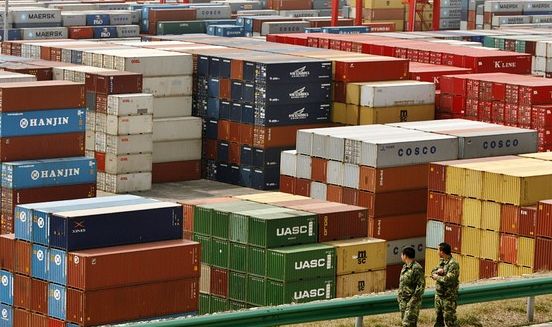
China surpassed the U.S. to become the world’s biggest trading nation last year as measured by the sum of exports and imports, a milestone in the Asian nation’s challenge to the U.S. dominance in global commerce that emerged after the end of World War II in 1945.
继2009年成为世界第一大出口国和第二大进口国之后,2012年,中国已基本确定在整体进出口贸易规模上超越美国,成为全球最大贸易国。
中国海关总署公布的数据显示,2012年中国外贸进出口总值38667.6亿美元,同比增长6.2%;其中出口20489.3亿美元,同比增长7.9%;进口18178.3亿美元,同比增长4.3%;贸易顺差2311亿美元。
美国预定2月11日公布2012年全年贸易数据。中国的《第一财经日报》根据美国已公布的2012年前11个月数据测算,即使美国2012年全年货物进出口总值达到38559.7亿美元,也仍然略低于中国海关总署公布的2012年中国全年货物进出口总值38667.6亿美元。
U.S. exports and imports last year totaled $3.82 trillion, the U.S. Commerce Department said yesterday. China’s customs administration reported last month that the country’s total trade in 2012 amounted to $3.87 trillion. China had a $231.1 billion annual trade surplus while the U.S. had a trade deficit of $727.9 billion.
China’s emergence as the biggest global trading nation gives it increasing influence, threatening to disrupt regional trading blocs as it becomes the most important commercial partner for countries including Germany, which will export twice as much to China by the end of the decade as it does to neighboring France, said Goldman Sachs Group Inc.’s Jim O’Neill.
“For so many countries around the world, China is becoming rapidly the most important bilateral trade partner,” O’Neill, chairman of Goldman Sachs’s asset management division and the economist who bound Brazil to Russia, India and China to form the BRIC investing strategy, said in a telephone interview. “At this kind of pace by the end of the decade many European countries will be doing more individual trade with China than with bilateral partners in Europe.”
U.S. Leadership
Still, the U.S. economy is more than double the size of China’s, according to the World Bank. In 2011, the U.S. gross domestic product reached $15 trillion while China’s totaled $7.3 trillion.
“It is remarkable that an economy that is only a fraction of the size of the U.S. economy has a larger trading volume,” Nicholas Lardy, a senior fellow at the Peterson Institute for International Economics in Washington, said in an e-mail. “The surpassing of the U.S. is not because of a substantially undervalued currency that has led to an export boom,” said Lardy, noting that Chinese imports have grown more rapidly than exports since 2007.
The U.S. emerged as the preeminent trading power following World War II as it spearheaded the creation of the global trade and financial architecture and the U.K. began dismantling its colonial empire. China began focusing on trade and foreign investment to boost its economy after decades of isolation under Chairman Mao Zedong. Economic growth averaged 9.9 percent a year from 1978 through 2012.
Biggest Exporter
China became the world’s biggest exporter in 2009, while the U.S. remains the biggest importer, taking in $2.28 trillion in goods last year compared with China’s $1.82 trillion of imports. HSBC Holdings Plc forecast last year that China would overtake the U.S. as the top trading nation by 2016.
China was last considered the leading economy during the height of the Qing dynasty. The difference is that in the 18th century, the Qing Empire — unlike rising Britain — didn’t focus on trade. The Emperor Qianlong told King George III in a 1793 letter that “we possess all things. I set no value on objects strange or ingenious, and I have no use for your country’s manufactures.”
While China is the biggest energy user, has the world’s biggest car market and the world’s largest foreign currency reserves, a significant portion of China’s trade involves importing raw materials and parts to be assembled into finished products and re-exported, an activity that provides “only modest value added,” Eswar Prasad, a former International Monetary Fund official who is now a professor at Cornell University in Ithaca, New York, said in an e-mail.
More Involved
Last month China’s trade expanded more than estimated, with exports rising 25 percent from a year earlier and imports increasing 28.8 percent, government data released yesterday showed. China’s trade figures in January and February are distorted by the week-long Lunar New Year holiday that fell in January of last year and started today.
Economists from banks including UBS AG and Australia & New Zealand Banking Group Ltd. recently questioned the veracity of China’s export data after the customs administration reported an unexpected 14.1 percent export gain in December. The General Administration of Customs defended the data last month, saying all statistics are based on actual customs declarations, and the Ministry of Commerce said the jump was caused by exporters who hurried shipments before a waiver of inspection fees expired at the end of the month.
Trade Deficit
The U.S.’s bilateral trade deficit with China, which peaked in 2012, could remain a flashpoint of tension between the two countries, according to Prasad said.
“This trade imbalance is not representative of the amount of goods actually produced in China and exported to the U.S., but this perspective tends to get lost amidst the heated political rhetoric in the U.S,” said Prasad.
According to O’Neill, the trade figures underscore the need to draw China further into the global financial and trading architecture that the U.S. helped create.
“One way or another we have to get China more involved in the global organizations of today and the future despite some of their own reluctance,” said O’Neill said, mentioning China’s inclusion in the International Monetary Fund’s Special Drawing Rights currency basket. “To not have China more symbolically and more importantly actually central to all these things is just increasingly silly.”

China 2013 trade passed $4 trillion
2014.01.10
BEIJING – China’s annual trade in goods passed the $4 trillion mark for the first time in 2013, official data showed Friday, confirming its position as the world’s biggest trading nation.
Exports from the world’s second-largest economy rose 7.9 percent to $2.21 trillion, while imports increased 7.3 percent to $1.95 trillion, the General Administration of Customs announced.
The trade surplus stood at $259.75 billion, up 12.8 percent from 2012.
The country’s total trade came to $4.16 trillion, an increase of 7.6 percent, which was just below the government’s target of 8 percent.